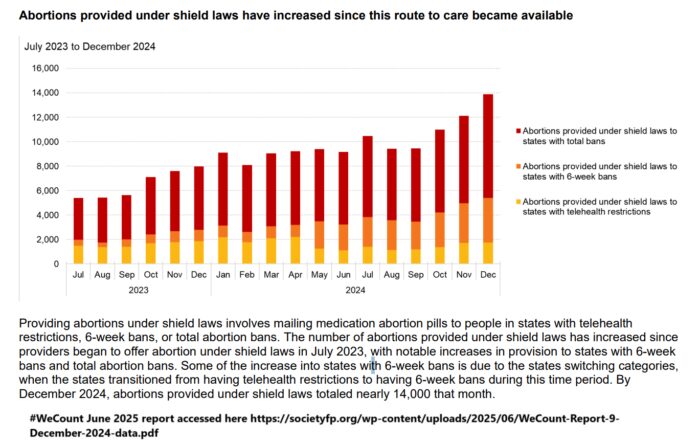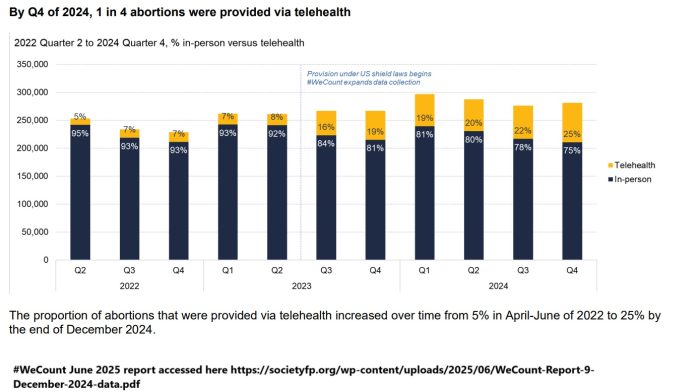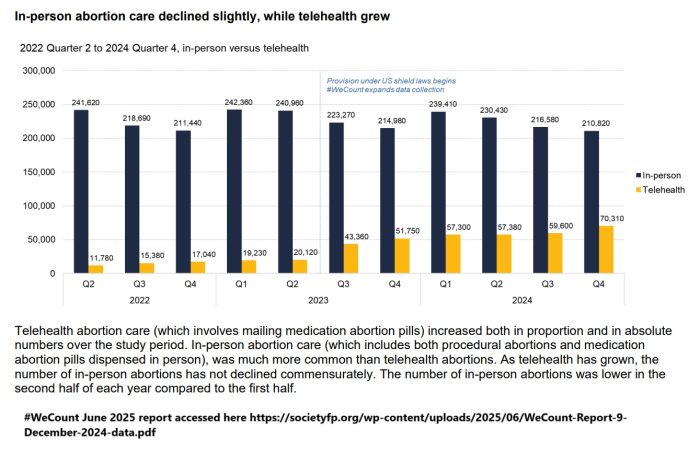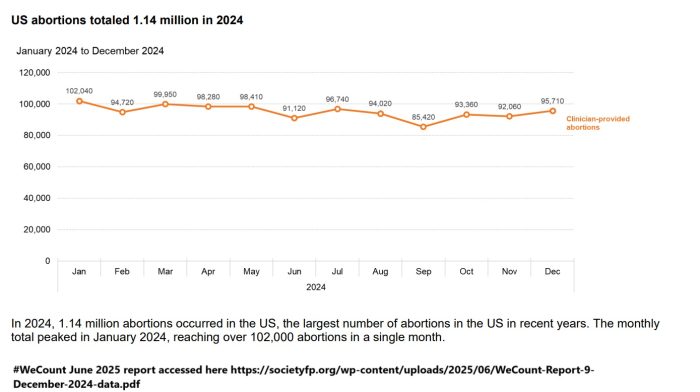A pro-abortion group says telehealth abortions — abortion pills shipped by mail from virtual abortion retailers, brick and mortar facilities, or pharmacies — rose in 2024, likely due to so-called “shield laws” enacted in pro-abortion states to protect those mailing abortion pills illegally into pro-life states.
But there are reasons to view this claim with a skeptical eye.
Key Takeaways:
- The pro-abortion group #WeCount states that telehealth abortions increased significantly from 2023 to 2024.
- They attribute the increase to “shield laws” enacted in pro-abortion states to protect doctors illegally mailing abortion pills into states where it is restricted.
- Some express skepticism, noting that the group didn’t begin tracking telehealth abortions until the latter half of 2023.
- Both reporting agencies, Guttmacher and #WeCount (of the Society of Family Planning), now choose to publish estimated data with greater frequency, rather than actual data with lesser frequency.
The Details:
A June 2025 report from the pro-abortion group #WeCount claims that while “majority of abortions occurred in-person… The number of abortions delivered via telehealth has continued to increase since April 2022, when #WeCount became the first national study to track telehealth.”
The group’s report analyzed abortion data from April 2022 to December 2024.

#WeCount for July 2023 to December 2024 abortions under shield laws abortions
#WeCount is a project of the pro-abortion Society of Family Planning (SFP), which is funded by the David and Lucile Packard Foundation and the Buffett Foundation, both of whom have invested in abortion pill manufacturer Danco Laboratories.
“By the end of 2024, 1 in 4 abortions was provided via telehealth,” #WeCount wrote.

#WeCount June 2025 reports one in 4 abortions are telehealth abortions
“Across the US, in states that permit abortion and telehealth provision of abortion, there is substantial variation in the proportion of abortions provided via telehealth, ranging from 7% to 40%. In several larger states, telehealth is a smaller share of the abortions, at about 9-12% of all abortions,” wrote #WeCount.
According to the #WeCount graph below, approximately 244,590 abortions were shipped via telehealth in 2024 alone while 897,240 were in person.

#WeCount for 2024 Telehealth v In Person abortions
“Telehealth abortions provided by virtual clinics (those that that are online only and have no brick-and mortar clinic) to states that permit abortion and telehealth abortion have increased since 2023,” #WeCount claimed. “Telehealth abortions provided by brick-and-mortar clinics have remained steady.
The group added:
Telehealth abortions provided into states with telehealth restrictions also remained relatively steady. Telehealth abortions provided into states with 6-week bans have increased; some of the increase into states with 6-week bans was due to the states switching from having telehealth restrictions to having 6-week bans during this time period.
Telehealth abortions provided into states with total bans increased substantially by the end of 2024.
#WeCount’s June 2025 report showed higher overall abortions in 2024 than previous years, conflicting somewhat with an analysis by the Guttmacher Institute, which showed abortions nationwide were “stabilizing.”
#WeCount’s abortion total for 2024 is more than 9% higher that the estimated “1,038,100 clinician-provided abortions in states without total abortion bans in 2024″ that was reported by Guttmacher earlier this year. This is likely due to #WeCount’s estimated counts of abortion pills shipped into states with pro-life protections.
“In 2024, 1.14 million abortions occurred in the US, the largest number of abortions in the US in recent years. The monthly total peaked in January 2024, reaching over 102,000 abortions in a single month,” #WeCount wrote. “Comparisons of year over year show that for most months the number of abortions in 2024 was higher than the number of abortions in the same month of 2023 or 2022.”
The group noted, “Shield laws continue to facilitate the receipt of medication abortion, with an average of 12,330 abortions per month provided under shield laws by the end of 2024.”

#WeCount June 2025 reports 1.14M abortions in 2024
What’s Happening:
Shield Laws
In an effort to protect abortion providers from prosecution after the overturning of Roe v. Wade, pro-abortion states have passed a litany of pro-abortion shield laws to thwart criminal or civil charges against abortionists filed by those in other states. This protects Big Abortion, not women and teens.
“During the last six months of 2023, only about 18 percent of abortions were done by telehealth. However, by the last quarter of 2024, over 25 percent of abortions were taking place via telehealth,” wrote Dr. Michael New, who analyzed the report. He added:
Furthermore, the data indicates that telehealth abortions are being facilitated by state-level shield laws. Shield laws make it more difficult for pro-life states to prosecute physicians who prescribe chemical abortions remotely.
The #WeCount estimates indicate that nearly half of the telehealth abortions that took place in 2024 were administered by physicians in states with shield laws.
New added that “The project found that in 2024, 1,142,230 abortions were performed — a reported increase of more than 8 percent from the previous year. A key finding from the #WeCount report was that over 21 percent of all abortions that took place in 2024 were done via telehealth.”
But while this may explain an increase, there is skepticism that there has even been a true increase.
Skewing the numbers?
New previously pointed out that pro-lifers should “view with some skepticism the abortion estimates from the Society of Family Planning,” writing of #WeCount’s previous data:
Telehealth abortions are self-reported by companies that send abortion pills through the mail. These companies may have incentives to inflate their numbers.
Live Action News also previously pointed out limitations to the accuracy and comprehensiveness of the previous #WeCount data, because in past reports SFP admitted that only 82% of the abortion facilities known to them provided data.
In its June 2025 report, #WeCount admits that its “[c]ounts are an underrepresentation of all abortions in the US” and that the group does not “have estimates of the proportion of people who did not take the medications sent to them.” The group admitted:
Some people may not have taken the pills, and we do not have an estimate of that.
Use of shield laws to provide abortion via telehealth into states with total or 6-week abortion bans or with telehealth abortion restrictions started in July 2023, and #WeCount began to count abortions provided under shield laws at that time.
Because of this transition in abortion provision, #WeCount does not have a comparator for previous months.
This was also pointed out by Dr. New, who wrote (emphases added):
Not surprisingly, there is less here than meets the eye. An important reason why the #WeCount project reported increasing abortion numbers in 2024 is because it started counting telehealth abortions only in July 2023.
It is certainly plausible that telehealth abortions became more prevalent in 2024. However, the fact that the project counted no telehealth abortions in the first six months of 2023 certainly skews the numbers.
It also means that the overall 2024 abortion estimates should not be directly compared with the overall 2023 estimates.
The Background:
Since the Dobbs decision in 2022, two agencies have attempted to publish estimated abortion data: the Guttmacher Institute and the Society of Family Planning (SFP) — or #WeCount.
Guttmacher’s Data Collection
Now, instead of reporting updated data every few years or so as it did prior to Dobbs, Guttmacher has chosen to publish monthly abortion estimates on a regular basis. Guttmacher’s monthly study “estimates the number of clinician-provided abortions that take place each month in each US state without a total ban,” but excludes “any abortions provided in states with total bans” as well as those obtained through online pharmacies or other means. This methodology is less reliable that what had been collected previous to the fall of Roe.
Guttmacher data now “exclude[s] any abortions provided in states with total bans (through shield law provision, community health networks, online pharmacies or other means),” Guttmacher wrote, “and therefore represent an underestimate of the total number of abortions nationally” (emphasis added).
In April, Live Action News reported that estimations provided by Guttmacher show that 14% of its recorded abortions in 2024 were via online abortion appointments, up from 10% in 2023, an increase of about 40,000 abortions. In March of 2024, #WeCount data found that in the first three months of 2024, the number of abortions increased by 13.8 percent and noted that telehealth abortions were on the rise.
By April 2025, Guttmacher’s analysis also revealed that telehealth’ abortion increased in 2024, though most abortions still took place in brick-and-mortar facilities.
#WeCount’s Data Collection
#WeCount claims to gather data from a “database of all clinics, private medical offices, hospitals, and virtual clinic providers in the US known to offer abortion care…”
However, unlike Guttmacher, #WeCount claims their “report also includes abortions provided under shield laws by US-based licensed providers who are following their own state law. The Society provided compensation to participating facilities for each monthly submission.”
#WeCount also claimed that “83% of the abortions across the study period were based on data obtained from providers or health departments, while the remaining 17% of the data were imputed.” The group noted that in “33 states and Washington, DC, some providers never reported to #WeCount.”
#WeCount added, “We developed separate imputations for virtual clinics that did not submit data to us, using the median number of abortions that were provided by other virtual clinics in the state.”
In otherwards, both reporting agencies are simply estimating.
Go Deeper:
Read more at these links about how abortion complications exist – and have been buried:
- Emergency room visits from abortion pill estimated in the tens of thousands
- FALLOUT: How dumping patients and pushing a lie misled everyone about the abortion pill
- Abortion pill complications buried for decades in abortion industry plot to hide the truth
Read more at these links about the weakening of abortion pill safeguards and recent attempts to end safety regulations:
- If the FDA removes abortion pill safety protocols, it won’t be because the drug is safe
- FDA permanently loosens abortion pill safety measures to allow pills by mail
- Federal law prohibits sending abortion drugs by US mail… so why isn’t it being enforced?
- Four states want FDA to excuse them from following abortion pill safety protocols







